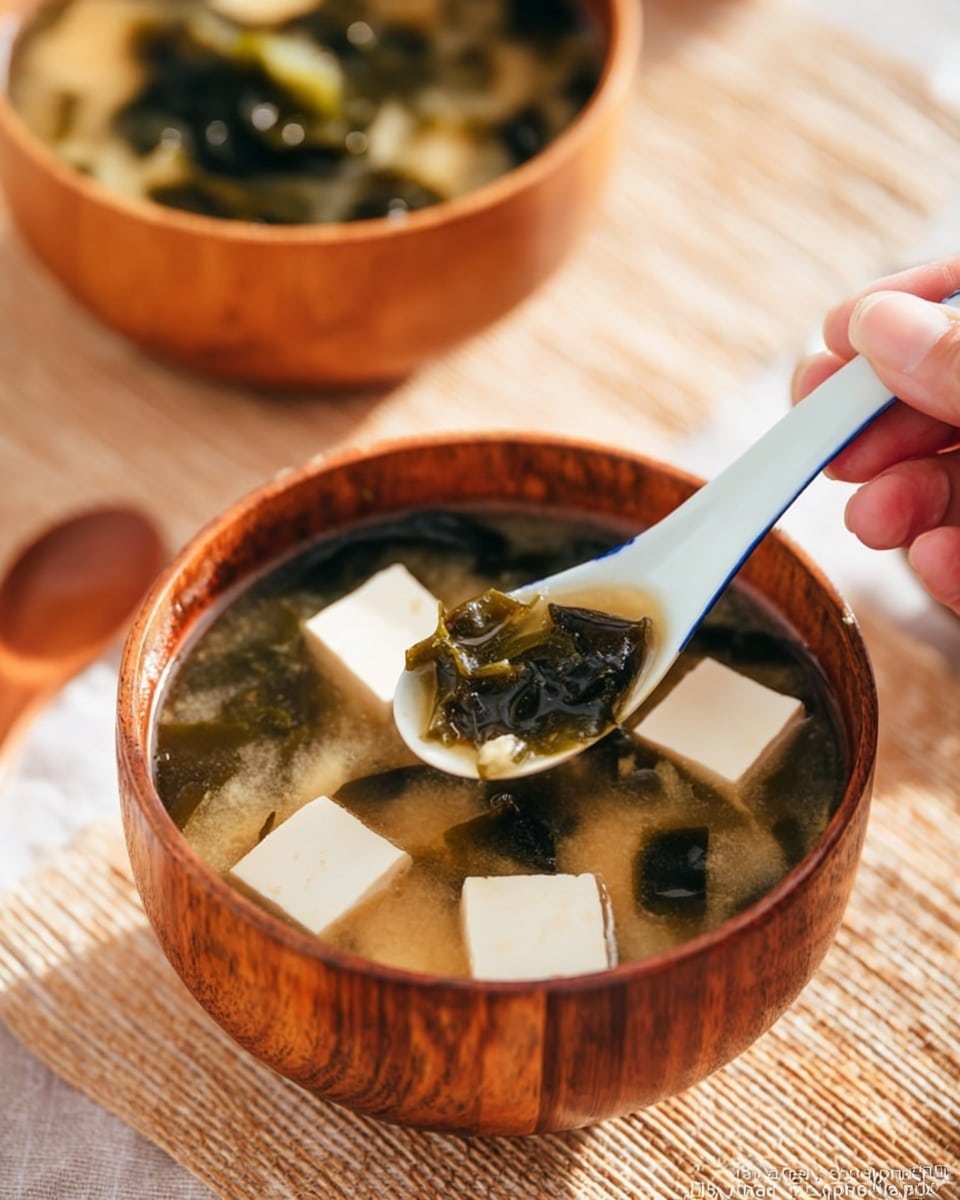If you’re looking for a heartwarming, nourishing bowl that comes together in no time, this Easy Miso Soup (Gluten Free) Recipe is an absolute must-try. It’s vibrant with umami flavors, thanks to the simple yet powerful ingredients like wakame seaweed, silky tofu, and naturally fermented miso paste. Whether you need a quick lunch, a cozy starter, or a light dinner, this soup fits every occasion with its comforting warmth and incredibly easy preparation.
Ingredients You’ll Need
The charm of this Easy Miso Soup (Gluten Free) Recipe lies in its straightforward, wholesome ingredients that each play a vital role in flavor and texture. From the mineral-rich wakame to the creamy tofu, each element elevates the soup without any fuss.
- 4 cups water: The perfect base to carry all the savory flavors smoothly.
- 1 teaspoon hondashi powder: Adds a subtle depth of traditional dashi flavor, making the soup truly authentic.
- ¼ cup wakame seaweed: Provides a slightly briny taste and beautiful green color, plus a chewy texture that complements the tofu.
- 8 ounces tofu: Soft and cubed, it balances the soup with protein and a silky frosting on your spoon.
- 4 tablespoons gluten free miso paste: The flavorful heart of the soup, available in white, yellow, or red varieties for a flavor twist.
- 1 stalk green onion: Thinly sliced for a fresh, subtle crunch and a pop of color that brightens the bowl.
You’ll find the full ingredient list, instructions, and print option in the recipe card below.
How to Make Easy Miso Soup (Gluten Free) Recipe
Step 1: Combine and Boil the Base
Start by bringing 4 cups of water to a rolling boil in a pot. Once bubbling, stir in the hondashi powder to kickstart the umami flavor. Immediately add the wakame seaweed and tofu cubes—the seaweed will soon rehydrate and become tender while the tofu warms through, infusing the broth with a creamy, delicate body.
Step 2: Simmer to Perfection
Turn the heat down to a high simmer once the soup comes back to a boil. Let it bubble gently for about 3 minutes to allow the wakame to soften fully and for the flavors to meld beautifully. This step is key to achieving that gentle yet rich character that makes miso soup so comforting.
Step 3: Add Miso Paste the Right Way
Turn off the heat before adding the miso paste. Use a small fine-mesh strainer to dissolve the miso into the hot broth, ensuring it blends smoothly without clumps. If you don’t have a strainer handy, simply scoop out some of the broth, whisk the miso paste into it until fully dissolved, and then return it to the pot. This preserves the beneficial probiotics by avoiding boiling the miso directly.
Step 4: Final Touches and Serve
Once the miso is fully incorporated, sprinkle in the thinly sliced green onions for a burst of freshness and color. Serve your Easy Miso Soup (Gluten Free) Recipe piping hot, and watch how this simple dish brings calm and delight with every spoonful.
How to Serve Easy Miso Soup (Gluten Free) Recipe

Garnishes
A sprinkle of chopped green onions is traditional, but you can also add toasted sesame seeds or a few drops of toasted sesame oil for a nuttier finish. Thin slices of fresh shiitake mushrooms or a dash of shichimi togarashi will add layers of flavor and texture, enhancing your soup’s natural charm.
Side Dishes
Miso soup pairs beautifully with steamed rice, a fresh cucumber salad, or even some light pickled vegetables. These sides keep the meal balanced, making your Easy Miso Soup (Gluten Free) Recipe not only comforting but satisfyingly wholesome for any mealtime.
Creative Ways to Present
Serve the soup in small, elegant bowls to create a cozy, inviting vibe. For a modern touch, ladle it into mini teacups or clear glass mugs to showcase the beautiful colors and textures. Adding a bamboo spoon completes this aesthetic and makes the experience even more special.
Make Ahead and Storage
Storing Leftovers
Your miso soup keeps well in the refrigerator for up to 2 days. Store it in an airtight container to preserve the fresh flavors and prevent the tofu from absorbing too much liquid. Give it a good stir before reheating so the flavors meld back together.
Freezing
Because miso soup contains delicate tofu and seaweed, freezing is not ideal as the texture can become compromised. For the best experience, enjoy your soup fresh or refrigerated for short-term storage.
Reheating
When reheating, warm the soup gently on the stove over low heat to avoid boiling out the flavors or breaking down the miso paste’s probiotics. Add the green onions fresh after warming to keep them crisp and bright.
FAQs
Can I use regular miso paste instead of gluten-free?
Yes, you absolutely can! While this recipe highlights a gluten-free version, regular miso paste works just fine if gluten is not a concern for you.
What is hondashi powder, and can I skip it?
Hondashi powder is a quick dashi granule that adds a savory depth and authentic Japanese flavor. If you skip it, your soup will still be tasty but less rich in umami, so it’s worth using for that classic taste.
Can I add other vegetables to this soup?
Definitely! Thinly sliced mushrooms, carrots, or daikon radish work wonderfully. Just add them at the boiling stage so they soften appropriately.
Is wakame seaweed the same as nori?
Not quite. Wakame is a rehydratable seaweed used in soups, giving a mild sweetness and soft texture, whereas nori is a dried seaweed sheet often used for sushi.
How do I know when miso paste is fully dissolved?
When adding the miso paste to warm broth, it should blend smoothly into a uniform liquid without grainy bits. Using a strainer or mixing miso in a separate bowl with some broth before adding helps achieve this perfectly.
Final Thoughts
There’s something truly special about a soup that feels both simple and magical at the same time, and this Easy Miso Soup (Gluten Free) Recipe fits that bill perfectly. It’s a comforting hug in a bowl, with the clean, wholesome flavors that make you want to come back for seconds. Do yourself a favor and give this recipe a try—it’s quick, satisfying, and perfect for any skill level in the kitchen.








